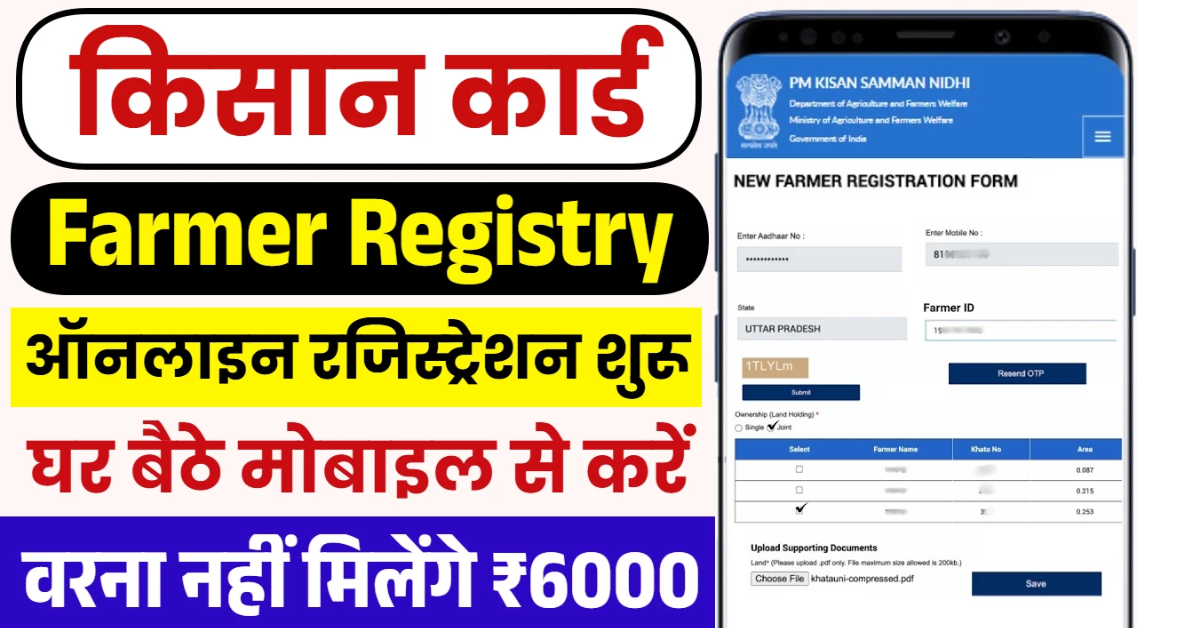The Government of India has taken a significant step toward digitizing agricultural services by launching the Farmer ID Registration 2025 initiative. This central program aims to streamline the delivery of agricultural schemes, subsidies, and welfare benefits by providing every eligible farmer a unique identification number—the Farmer ID.
Through this ID, farmers can gain access to direct government support, simplified application for various schemes like PM-KISAN, crop insurance, fertilizers, and real-time updates from agricultural departments.
Here is a comprehensive guide to help you understand the process of registering for Farmer ID in 2025, its eligibility criteria, required documents, benefits, and how it will impact the lives of Indian farmers.
✅ What is Farmer ID?
The Farmer ID is a unique digital identity assigned to individual farmers across India. It functions like an Aadhaar card but is exclusive to agriculture-related benefits and government schemes.
With the Farmer ID, all the farmer’s information—such as landholding, crop type, irrigation details, and past subsidy records—will be linked and stored digitally to ensure faster and more transparent governance.
🔍 Objectives of Farmer ID Registration 2025
The core objectives of launching this digital Farmer ID include:
- Creating a centralized database of farmers in India
- Ensuring faster implementation of schemes and financial aid
- Eliminating duplicate and fraudulent entries
- Empowering small and marginal farmers through direct benefits
- Tracking crop patterns and regional productivity for better policymaking
📅 When and Where to Apply
The online registration for Farmer ID 2025 has already started across various states. Farmers can register through:
- State agriculture department portals
- Common Service Centers (CSC)
- District-level Krishi Bhavans
- Official mobile apps released by state governments
Some states may also enable door-to-door registration through trained agriculture officers.
🧾 Required Documents for Farmer ID Registration
Before applying, farmers need to keep the following documents ready:
- Aadhaar Card (mandatory)
- Land ownership documents or Khasra-Khatauni
- Bank account details with IFSC code
- Passport-size photograph
- Mobile number linked with Aadhaar
- Ration card or caste certificate (if applying under special categories)
- Income certificate (if required for particular schemes)
🧑🌾 Who Can Apply?
✅ Eligibility Criteria:
- Must be an Indian citizen
- Must be involved in agricultural activities, either self-owned or leased
- Tenant farmers, sharecroppers, and women farmers are also eligible
- The applicant must be above 18 years of age
There is no restriction based on land size, which makes this scheme inclusive even for marginal and landless farmers.
🖥️ How to Register Online for Farmer ID in 2025
Here is a step-by-step guide to apply online for the Farmer ID:
Step 1: Visit Official Portal
Go to your state agriculture department website or centralized farmer registration portal (if provided).
Step 2: Click on “Farmer ID Registration 2025”
Locate the section for new registration and click on the appropriate link.
Step 3: Fill the Application Form
Enter the following details:
- Farmer’s Name
- Father’s Name
- Aadhaar Number
- Land details (Survey number, area, type of crop)
- Bank Account Details
- Mobile number and email (optional)
Step 4: Upload Documents
Scan and upload all required documents in the prescribed format.
Step 5: Submit and Get Acknowledgement
After review, submit the application. You will receive a reference number or acknowledgment slip for tracking.
Step 6: Verification & Approval
The agriculture department will verify the documents, and upon approval, your Farmer ID will be generated and sent via SMS or email.
📋 Offline Registration Option
For farmers who do not have access to smartphones or the internet, offline registration is available through:
- Common Service Centers (CSC)
- Local Agriculture Officer
- Block-level offices
They can fill out a physical form and submit it along with photocopies of documents.
🎁 Benefits of Farmer ID
Registering for a Farmer ID can provide direct and long-term benefits to farmers, such as:
✅ 1. Access to Government Schemes
- PM-KISAN Yojana
- Fertilizer Subsidy
- KCC (Kisan Credit Card)
- Crop Insurance (PMFBY)
- Free electricity or irrigation pumps (where applicable)
✅ 2. Faster Subsidy Transfer
- All benefits will be directly credited to linked bank accounts without middlemen.
✅ 3. Digitized Land & Crop Record
- Useful during natural calamity claims, loan applications, or damage assessments.
✅ 4. AI-Driven Farming Guidance
- Farmer ID may allow access to personalized crop advisory services, weather alerts, and pest control guidance.
✅ 5. Avoidance of Duplicate Applications
- Ensures transparency and integrity in scheme distribution and avoids double claims.
📊 Impact on Indian Agriculture
The Farmer ID initiative will play a transformative role in digitizing agriculture and boosting productivity. It is expected to:
- Reduce paperwork and corruption
- Improve government planning based on real-time data
- Enable faster disaster relief
- Help small and marginal farmers get recognized in national schemes
- Create a data-backed farming ecosystem
🛑 Common Mistakes to Avoid
- Entering wrong Aadhaar or land details
- Uploading blurry or mismatched documents
- Not linking the correct bank account
- Ignoring the acknowledgment number for tracking
Farmers should double-check entries to avoid application rejection or delays.
📞 Helpdesk and Grievance Redressal
Each state agriculture department has set up a dedicated helpline number and email ID for queries related to Farmer ID registration. Farmers can also visit their local Krishi Bhavan for on-ground support.
📌 Conclusion: Why Every Farmer Should Register
The Farmer ID Registration 2025 initiative is a game-changer for Indian agriculture. It is not just a registration form—it’s a gateway to multiple government benefits, real-time support, and financial inclusion for rural farmers.
With the increasing digitization of services, Farmer ID will become essential in the coming years. Every farmer—regardless of landholding size—should make it a priority to register, verify, and stay updated on this initiative to reap maximum rewards.

